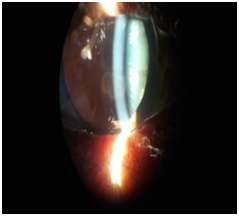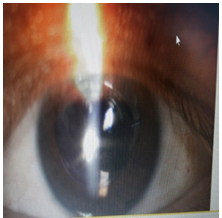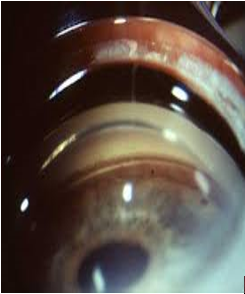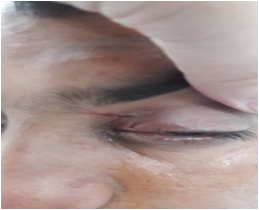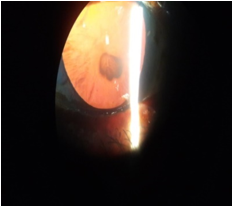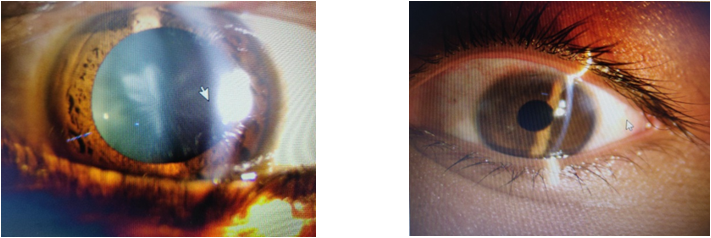Case Report
Volume 2 Issue 1 - 2020
Ocular Trauma in Young
Military Hospital Yol, Himachal Pradesh
*Corresponding Author: Dr. Rishi Sharma, Military Hospital Yol, Himachal Pradesh.
Received: April 12, 2020; Published: April 17, 2020
Abstract
Purpose: To describe presentation and management of ocular trauma in a series of 6 young patients (10-40 years of age)
Design: Retrospective case series
Place and duration of study: Place and duration of study: Military Hospital Yol Cant, Himachal Pradesh March 2019-Dec2019
Methods: A series of cases of ocular trauma in young were evaluated and effectively managed at a single centre.
Results: Six patients of ocular trauma were studied and managed. Out of six patients four were males and 02 females. Male female ratio was 4:2. Out of 6 cases 5 cases had traumatic cataract and one had angle recession. Four out of six patients required surgical intervention while 02 patients were managed with medical therapy
Conclusions: Eye injuries resulting from ocular trauma pose a frequent threat to vision the world over. While a focussed history and prompt ocular examination are essential to immediate management, patient education regarding safety precautions and risk reduction help to prevent future recurrences.
Keywords: Rosette cataract Closed globe injury; Fire-cracker injury; Angle recession; Hyphema
Introduction
Despite the anatomic and functional protective mechanisms of the visual system the incidence of ocular trauma is relatively common and occurs most frequently in men and young people. [1] Worldwide, an estimated 1.6 million people are blind as a result of eye injuries, and a further 19 million have monocular blindness or low vision due to eye trauma. [2] Several guidelines for ocular trauma have been published to help determine the visual prognosis. Visual outcome generally depends on the initial visual acuity, pupillary reflex response, and severity of the trauma. [3] Prompt evaluation and appropriate management of ocular injuries are paramount in the preservation of vision. Visual acuity, presence of an afferent pupillary defect, the type of injury, the location, and extent of penetrating injury, type of lens damage, presence and severity of vitreous hemorrhage, presence and composition of intraocular foreign bodies mostly contribute to the final visual outcome in patients suffering penetrating ocular injuries. [4]
In this article, we will focus on the presentation and management of ocular trauma through a series of six cases.
Methodology
Written informed consent was obtained from all the patients. Comprehensive medical and ocular histories besides age, sex of the subjects was obtained. Thereafter, a detailed ocular examination was performed. Patient's data including demographic details, causative agents, initial visual acuity, intraocular pressure, slit lamp examination findings, B-scan findings, treatment/surgery, early and late complications and final outcome were endorsed in the patients’ records. Patients were subsequently followed-up on 1 day, 1 week, 6 weeks, 3 months and 6 Months postoperatively. At each follow-up visit patient's visual acuity was recorded. Final best corrected visual acuity (BCVA) was recorded on the 5th postoperative visit i.e. at 6 months.
Case 1
36 yrs old male non-hypertensive/non diabetic reported with history of history of trauma to left eye while playing cricket and developed pain, redness and diminution of vision in left eye. Individual had Visual acuity of FCCF (finger count close to face)/PR (Projection of rays) Accurate in left eye. Right eye anterior segment and fundus exam-WNL. Left eye had anterior segment-WNL. Fundus examination media was hazy due to dense vitreous haemorrhage. USG B Scan showed no retinal detachment in left eye. He was diagnosed as a case of Closed globe injury left with Vitreous haemorrhage LE. He was conservatively managed with topical cycloplegics, steroids and IOP lowering agents. After one month individual was called for follow-up and DVL-6/24 in left eye. There was rosette cataract in his left eye (figure 1) and the vitreous haemorrhage had resolved fully. Fundus examination –WNL. IOP- 14mm Hg and 15 mm Hg. He underwent Phaco with PCIOL. Post op period DVL-6/9 unaided cornea-lustrous. Traumatic mydriasis. PCIOL in situ. Fundus- WNL. (Figure 2)
Patient was kept on follow-up and after about 2 months patient complained of diminution of vision in operated eye. Visual acuity was 6/12. PCO was noted. Macular edema detected and confirmed on OCT (CMT in Rt eye was 325 microns). YAG capsulotomy was done in the operated eye and patient placed on topical Nepafenac. Now after 6 weeks reported with vision of 6/6 and IOP 12 mm Hg(RE) and 13mmHg(LE).
Case 2
10 years old girl presented with history of injury in left eye due to stone thrown by another kid while playing. Post injury she developed pain, redness & diminution of vision with gross lid edema in left eye. Ocular examination revealed visual acuity of 6/6 in right eye and 6/60 in left eye with no further improvement. Right eye- Ant segment & Fundus –WNL. Lt Eye – Upper lid hematoma. Cornea- epithelial defect present. AC- grade 3+ cells and intense flare was noted. Pupil – sluggishly reacting to light due to synechiae. Fundus- Rest of the details were not visualized. IOP- 16(RE) mm Hg & LE- not recordable. She was diagnosed as a case of Closed Globe injury with Post traumatic uveitis left eye. She was started on Topical antibiotic steroids along with cycloplegics. After 04 weeks of treatment she had Visual acuity of 6/12 unaided in the left eye. AC- no cells and flare. Lens –pigments over capsule (figure 4). Fundus – WNL. IOP-14 mm Hg (RE) & 13 mmHg (LE). She has been placed on follow up.
Case 3
37 years old male patient presented with history of trauma in right eye one month back sustained with shuttlecock while playing. Post injury he complained of painful diminution of vision with redness and photophobia in the right eye. Right eye: DVR- PL+ PR accurate. Lid edema present. Deep ciliary congestion. Cornea- Multiple superficial abrasions. AC- Gd 3(1/2 AC volume) Hyphema. Traumatic mydriasis present. Lens- transparent. Fundus exam-WNL Left eye: Ant seg & Fundus exam-WNL. IOP was 45 mmHg (RE) & 16 mmHg (LE). Patient was started on anti-glaucoma medications (Tab Diamox & e/d Timolol with e/d Brimonidine. IOP reduced to 22mmHg in right eye. Reviewed after 01 month. Ocular examination revealed DVR-6/6 DVL-6/6. Right eye – Cornea lustrous. AC- no hyphema. Traumatic mydriasis present. Lens-clear. Fundus exam-WNL. Gonioscopy done in both eyes revealed grade 4 open angles with angle recession about 5-6 clock hrs in RE with iris processes (Figure 5). IOP-22 mmHg (RE) & 16 mm Hg (LE). Patient kept on follow-up as a case of closed globe injury with Angle recession Glaucoma Right eye.
Case 4
32 yrs old male sustained trauma in left eye while grass cutting and developed, pain, redness and diminution of vision in left eye with photophobia and watering Ocular examination revealed DVR of 6/6 in right eye Ant Segment & Fundus- WNL. DVL- 6/24 unaided with no improvement. Superficial Laceration 3 mm in size over medial aspect of left upper lid. Cornea- epithelial defect. Pupil- brisk reacting. Lens posterior- subcapsular cataract. Zonular dialysis seen from 6-9’o clock position (3 clock hrs). Fundus- WNL.IOP-17 & 18 mm Hg with NCT. On first sitting lid laceration was sutured. Subsequently he underwent Phaco with PCIOL implantation in left. He was kept on routine post-op cataract surgery drug regime. Post op DVL -6/6 unaided. Cornea – lustrous. PCIOL in capsular bag. Fundus- WNL. IOP-12 and 13 mm Hg.
Case 5
27year-old male patient presented with history of trauma to his left eye one month back sustained with pin of a rifle while cleaning the weapons in his unit. Post injury he developed pain, redness and diminution of vision in the left eye. Vision at presentation was 6/6 unaided in the right eye and 6/24 in the left eye with no further improvement. Lids and adnexa were normal with no retained foreign body in both eyes. Right eye anterior segment and fundus evaluation was normal. Left eye had clear cornea, no cells and flare in AC, no hyphema. Pupillary reactions were normal, no iris sphincteric tear was seen. Rosette shaped cataract was seen.no lens subluxation/ zonular dialysis/ phacodonesis. Fundus examination was normal. Ultrasonography B Scan of both eyes was normal. IOP was 16 mm Hg(RE) and 20 mm Hg(LE).The individual was taken up for cataract surgery. Phacoemulsification with Intraocular lens implantation was done. Post-operative day vision was 6/6 unaided, clear cornea, mild AC reaction normal reacting pupil with well centred IOL in capsular bag. IOP was 16 and 19 mm Hg .Patient was placed on topical antibiotic and steroid eye drops. He has been kept on regular follow-up. Last check-up(after 01 month) revealed vision of 6/5 unaided in the left eye, clear cornea, quiet AC, and well centred IOL in capsular bag. Fundus- normal. IOP- 14 and 16 mm Hg with applanation tonometry. Gonioscopy revealed open angles grade 4 with no signs of angle recession both eyes. The steroid antibiotic drops were tapered off as per the standard regime followed. The patient has been counselled and advised to report immediately in case of pain, redness, diminution of vision, floaters, and flashes in the operated eye.
Case 6
33 yrs old female sustained injury in right eye with part of a burnt cracker hitting her eye directly while she was watching the fireworks during Diwali. Post injury she had vision of PL positive with PR accurate. Left eye had vision of 6/6. Right eye- lids and adnexa normal, cornea- clear, whole of lens with ruptured capsule in AC, vitreous in AC. No further details were visible. IOP was 34 in right eye which ruled out a rupture globe. USG B scan revealed an attached retina. 200 ml iv mannitol was given followed by hourly antibiotic, steroid and cycloplegics. Once the IOP was reduced to 22, the lady was undertaken for lens removal. A modulated low phaco setting with anterior vitrectomy was done. No capsular rim, the lady was left aphakic. Post-op DVR was PL+ with PR accurate with no further improvement. There was macular edema. She was kept on follow-up and after 3 months she was implanted a glued IOL. However, despite the resolution of macular edema, vision did not improve and stayed at CFCF. Patient kept on long term anti -glaucoma medications and monthly IOP check with 6 monthly review at vitreo-retinal centre. IOP is 19 mm Hg in the rt eye with eye drop Timolol.
Discussion
Ocular trauma is the leading cause of unilateral blindness all over the world and is is more common in males than females [5]. In this study, male preponderance was found with a male to female ratio of 4 : 2.Traumatic cataract is common sequelae of ocular injuries in adults and children. [6] Worldwide males are more commonly involved in traumatic cataract than females. [7] Management of traumatic cataract that results from either blunt or penetrating ocular trauma needs special consideration because of associated injury to ocular and peri-orbital structures. In this case series there were 05 out of 06 cases had traumatic cataract. Four (04) out of them underwent cataract surgery and one patient 10 years old girl was medically managed and kept on follow-up. Traumatic cataract poses a significant medical and surgical challenge to an ophthalmologist. A detailed history, careful examination and a clear management plan can simplify these cases and provide the best possible visual outcome [8,9]. In the setting of trauma, phacoemulsification parameters should be conservative, for instance, using a low bottle height (60-75 cm), low aspiration rate (18-20 cc/min), and proportionally low vacuum (180-200 mm Hg). Ultrasound power varies depending on the hardness of the cataract. Conservative phaco settings were used in all cases. In case scenario 5 patient was young 27 yrs old male with traumatic cataract which was soft in consistency with no associated injury to the surrounding ocular structures and therefore, we used I/A Cannula to aspirate the lens after good hydrodissection. [10]
Cataract and glaucoma resulting from ocular trauma can occur in the setting of both penetrating and blunt injuries, thus both open and closed globe injuries [11]. Glaucoma can occur due to various mechanisms like Angle recession glaucoma, Lens Dislocation, Lens particle glaucoma, Hemolytic or ghost cell glaucoma post vitreous haemorrhage. Treatment of post-traumatic glaucoma is aimed at reducing IOP by decreasing aqueous formation by the ciliary body, preventing further obstruction to aqueous outflow, or creating an alternate aqueous drainage route. An aqueous washout procedure can be used in cases of uncontrolled IOP elevation related to hemorrhage. Angle recession is a tear between the longitudinal and circular muscles of the ciliary body [11] .Ten percent of patients with angle recession that involves more than 2/3 of the angle develop glaucoma secondary to scarring of angle structures. The damage from angle recession is seen as a widening of the ciliary band on gonioscopy (figure 5). Treatment involves topical and, in some cases, oral medications to reduce a high intraocular pressure in the days following the trauma. Patients with significant angle recession injuries should be followed by an ophthalmologist for IOP elevations, visual field testing, and optic nerve changes. [12,13]
Ocular trauma inflicted by fireworks can have serious consequences for ocular morbidity and visual acuity, especially in severe trauma which affected younger patients. Of all reported ocular injuries, 1.6-2% are due to injury by firecrackers. [14,15] Injuries to onlookers are also very common (14-61%). [16,17] Fireworks-related ocular injuries include a variety of clinical manifestations. Visual outcomes arefrequently poor and visually devastating. [18] In case scenario 6 the young lady suffered injury while watching the fireworks. She had traumatic cataract, macular edema and despite all measures, the vision of the female remained CFCF.
Limitation
A major limitation of this study is a small sample size and a fixed follow-up period. Yet the findings, surgical approach and medical management is in consonance with the earlier studies on ocular trauma.
A major limitation of this study is a small sample size and a fixed follow-up period. Yet the findings, surgical approach and medical management is in consonance with the earlier studies on ocular trauma.
Conclusion
Most of the ocular trauma occurs in younger males of productive age groups. Management of traumatic cataract for good visual outcomes requires a holistic approach consisting of meticulous pre-op evaluation, uneventful surgery and post-op follow-up to evaluate and manage any delayed complications which could hinder post-op recovery of vision. Ocular trauma can be avoided employing some basic precautions. Once the injury has occurred, outcome depends upon extent of injury and professional approach must be taken to reduce complications.
Ethical standards
The current study has been approved by the ethics committee of the institute and has therefore been performed in accordance with the ethical standards laid down in the 1964 declaration of Helsinki and its later amendments.
The current study has been approved by the ethics committee of the institute and has therefore been performed in accordance with the ethical standards laid down in the 1964 declaration of Helsinki and its later amendments.
Conflict of interest
The authors declare that they have no conflict of interest.
The authors declare that they have no conflict of interest.
References
- Serna-Ojeda JC et al. (2015). Int Ophthalmol. 35(4): 451-458.
- Négrel A ? D, Thylefors B. (1998). The global impact of eye injuries. Ophthalmic Epidemiology 5143–169.
- Schein O D, Hibberd P L, Shingleton B J. (1989). The spectrum and burden of ocular injury. Ophthalmology 5300–305.
- Sharma AK, Shah DN, Shrestha JK, Thapa M, Shrestha GS. (2014). Ocular injuries in the people's uprising of April 2006 in Kathmandu, Nepal. Nepal J Ophthalmol. 6(11): 71–79.
- Wong TY, Klein BE, Klein R. (2000). The prevalence and 5?year incidence of ocular trauma: the Beaver Dam study. Ophthalmology. 107(12): 2196?2202
- Sarikkola AU, Sen HN, Uusitalo RJ, Laatikainen L. (2005). Traumatic cataract and other adverse events with the implantable contact lens. J Cataract Refract Surg. 31: 11–24.
- Ashvini K, Robin R, Kimberly G. (2009). Surgical intervention for traumatic cataracts in children: epidemiology, complications and outcomes. J AAPOS 13: 170-4.
- Kanski JJ. (2018). Clinical Ophthalmology: A Systematic Approach. 894-915.
- Mester V, Kuhn F. Ocular trauma: principles and practice. New York (NY): Thieme; 2002. Lens In: Kuhn F, Pieramici DJ. Editors; pp. 180–204. ]
- Shah, M. A., S. M. Shah, Shashank Shah et al. (2011). Morphology of traumatic cataract: does it play a role in final visual outcome? BMJ Open 1: e000060.
- Khatri SK, Lewis AE, Schein OD, Thapa MD, Pradhan EK, Katz J, et al. (2004). The epidemiology of ocular trauma in rural Nepal. Br J Ophthalmol. 88:456-60.
- Chuka OM, Obizoba OL. (2012). Paracentesis as surgical intervention in traumatic hyphaema: opinions and practices of nigerian ophthalmologists. Ophthalmol Eye Dis. 4: 71-78.
- De Leon-Ortega JE, Girkin CA. (2002). Ocular trauma-related glaucoma. Ophthalmol Clin North Am. 15(2): 215-223.
- Mohan K, Dhir SP, Munjal VP, Jain IS. (1984). Ocular fireworks injuries in children. Afro-Asian J Ophthalmol 2: 162-65.
- Arya SK, Malhotra S, Dhir SP, Sood S. (2001). Ocular fireworks injuries. Clinical features and visual outcome. Indian J Ophthalmol 49: 189-90.
- Wilson RS. (1975). Ocular fireworks Injuries. Am J Ophthalmol 79: 449-51.
- Wisse RPL, Bijlsma WR, Stilma JS. (2010). Ocular Firework Trauma: a Systematic Review on Incidence, Severity, Outcome and Prevention. Brit J Ophthalmol 94(12): 1586.
- Lin, Ying, et al. (2012). Prognostic Factors and Visual Outcome for Fireworks-Related Burns During Spring Festival in South China. Journal of Burn Care & Research 33(3): e109-e114.
Citation: Rishi Sharma and B.V Rao. (2020). Ocular Trauma in Young. Journal of Ophthalmology and Vision Research 2(1).
Copyright: © 2020 Rishi Sharma. This is an open-access article distributed under the terms of the Creative Commons Attribution License, which permits unrestricted use, distribution, and reproduction in any medium, provided the original author and source are credited.

